Silk Reeling #NeedleworkMonday
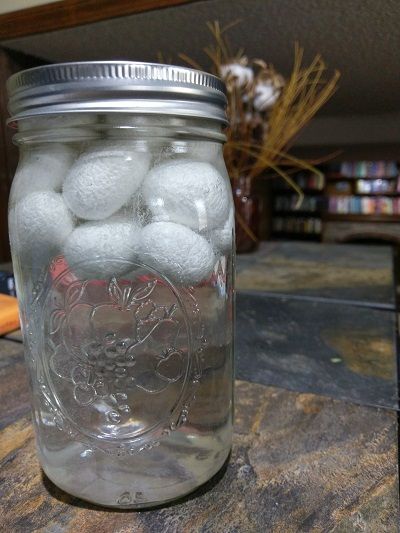
The art of reeled silk.... the highest quality silk. Reeled silk is produced by reeling a continuous filament from several silkworm cocoons at once. It is not spun. It contains next to no twist. The fibers are microscopically smooth. This results in some of the most lustrous threads you will likely experience. Silk also sucks up color and produces brilliant, rich tones.
Reeling silk begins with the silk. You need whole, uncut cocoons to reel from. Many individuals raise their own worms. Depending on where you live, there are legal restrictions on the importation of cocoons, as the insect is still inside. Often times, the cocoons are cut open and the pupae removed. Silkworms build their cocoons from 1 long strand, so cut cocoons can't be reeled. If you get your hands on cut cocoons, these are great for making silk mawata, another spinning preparation.
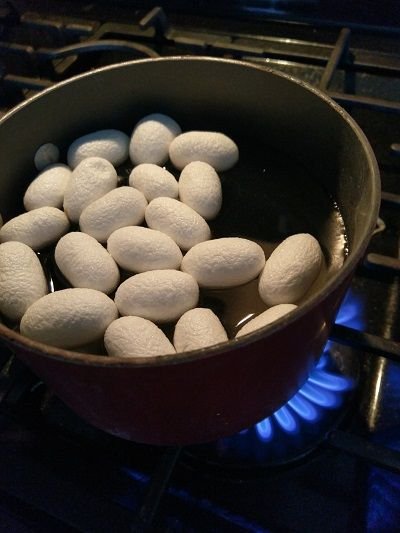
The cocoons are first soaked in hot water in a mason jar or any jar with a lid. The lid keeps the cocoons submerged and helps them to fully saturate. I soak my cocoons for several hours to overnight. Then I transfer my cocoons to a pot on the stove where I boil them for about half an hour. The cocoons will fizz as air is pushed out of them. This softens the sericin, a protein produced by the silkworm along with the silk. This protein acts as the "glue" that holds the fine strands of silk together.
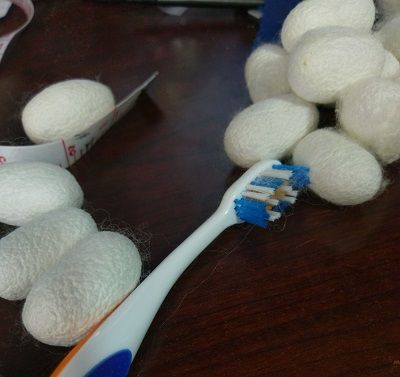
Once boiled, I remove my pot from the stove. One by one, I use a toothbrush (the one I get from my six month dental checkup!) to gently stroke the surface of the cocoons to find the one true end. There are usually a few false starts, waste fiber that the silkworm larvae used to anchor their cocoon. Once I find the one true end, I transfer the cocoon to a heated crockpot. It is important to maintain heat during the reeling process, to keep the sericin pliable.
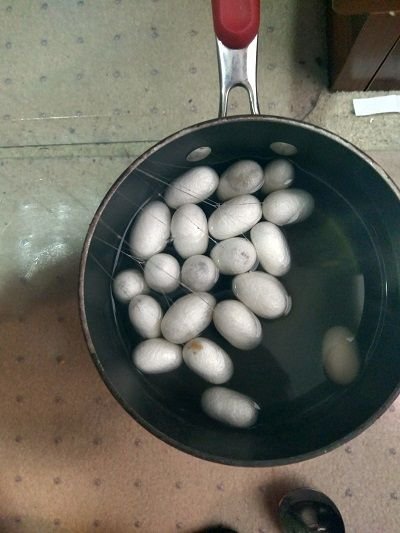
My reeling setup consists of a crock pot, a skein winder and a ball winder. I cover the pegs of my skein winder with plastic to keep the silk filament from sticking to my tool and gumming it up. All of the strands of silk go through the yarn guide of my ball winder. This gathers all twenty strands into one point. As the silk is reeled from the pot, it dries before it makes it to the skein winder and "glues" the strands together with the quickly drying sericin. While reeling, the silk feels as if it might break at any moment, but have faith in it. It is stronger than it looks!
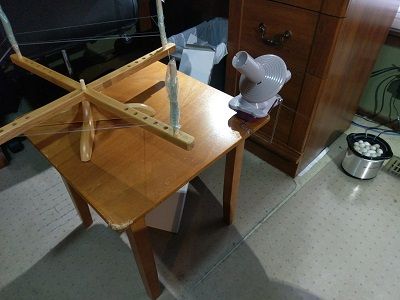
Once the prime silk is reeled off, the pot contains the remaining silk net around the pupae. I then wind the silk filament from my skein winder to a toilet paper cardboard tub on my ball winder. This helps to keep the filament from becoming tangled. It can now be reeled with other silk to create a thicker thread or thrown to add twist. Just remember, twist will reduce your luster.
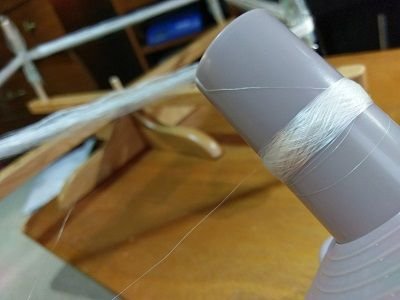
Reeled silk can be used in embroidery, weaving, tapestry... Silk's qualities -- strength, breathability, moisture-wicking, anti-microbial fibers, warmth -- make it a fiber with incredible possibility and a variety of use.
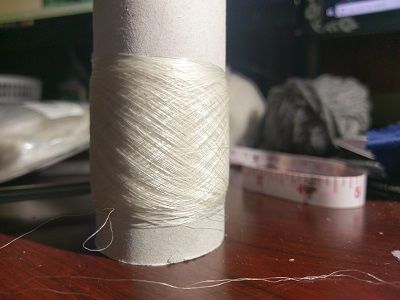
There are some controversies surrounding silk production. Many individuals find it inhumane to kill the pupae before they develop into moths. They propose that moths be allowed to emerge before the silk is harvested. On the other side of this argument, silk moths are born without mouths. They mate, lay eggs, and starve to death within a week of emerging from the cocoon. And once the moth breaches the cocoon, the silk can no longer be reeled. It is a tricky discussion.
Silkworms can be somewhat difficult to keep alive. Temperature, diet, moisture and disease make sericulture a tricky business. With great risk comes great reward. While most western cultures avoid eating insects, silkworm pupae are considered a delicacy in many areas and are full of protein. If you do decide to partake, I recommend only consuming silkworms you've raised yourself. There is no telling how long purchased cocoons have sat in storage.
While I imagine it may be difficult to find a home use for sericin, it does have use in the bio-medical field, notably as a liquid suture. Strong, sticky, and anti-microbial, it works well in this application.
Sericulture may seem strange or gross to the uninitiated, but I can assure you that the pupae are not as "bug-like" as you might expect. The fiber is spectacular. To me, the benefits far outweigh and ick-factor I may have!
.png)
All photos and text property of @luthvarian
Congratulations! This post has been upvoted from the communal account, @minnowsupport, by luthvarian from the Minnow Support Project. It's a witness project run by aggroed, ausbitbank, teamsteem, theprophet0, someguy123, neoxian, followbtcnews, and netuoso. The goal is to help Steemit grow by supporting Minnows. Please find us at the Peace, Abundance, and Liberty Network (PALnet) Discord Channel. It's a completely public and open space to all members of the Steemit community who voluntarily choose to be there.
If you would like to delegate to the Minnow Support Project you can do so by clicking on the following links: 50SP, 100SP, 250SP, 500SP, 1000SP, 5000SP.
Be sure to leave at least 50SP undelegated on your account.
Your post are always so interesting. Thank you for another one!
Thank you!
Wow you just keep on Amazing with the knowledge and skills you have dealing with fiber arts. I once watched a video that showed this process and it was very interesting just like this post. Thank you for showing the process as well as the education part along the way. The whole process of getting this silk is so neat. I am really loving the different aspects you bring to #NeedleWorkMonday! Thank you!
Thank you. :-) Fiber arts is my passion, so I'm always happy to share!
You’re very welcome ~ 😊 We are so glad you’re here!
Thank you! interesting article. I did not know how this process goes before
This is a great post! Thanks for sharing all that goes into silk. I love the fiber but knew next to nothing about how it is processed. Really enjoying your content ☺
This is interesting - I have never actually seen this process in action. What a great post!
Wow, I am blown away, @luthvarian! I didn't know a single thing about silk production until I read your post. This is incredible! Happy #NeedleworkMonday to you!
@luthvarian ... I had read about the process but didn't quite know of anyone actually being able to do it... Impressive !
You are a flippin' wizard! This was absolutely fascinating. I would love to see some of this silk after you have dyed it. The bug factor is too much for me, but I really love the many wonderful properties of the fiber.
I like it... a wizard! lol. I'll be doing silk reeling and dyeing all through February, so I promise I'll post more about it soon!
Wow, every day I'm learning weird and interesting things on Steemit!